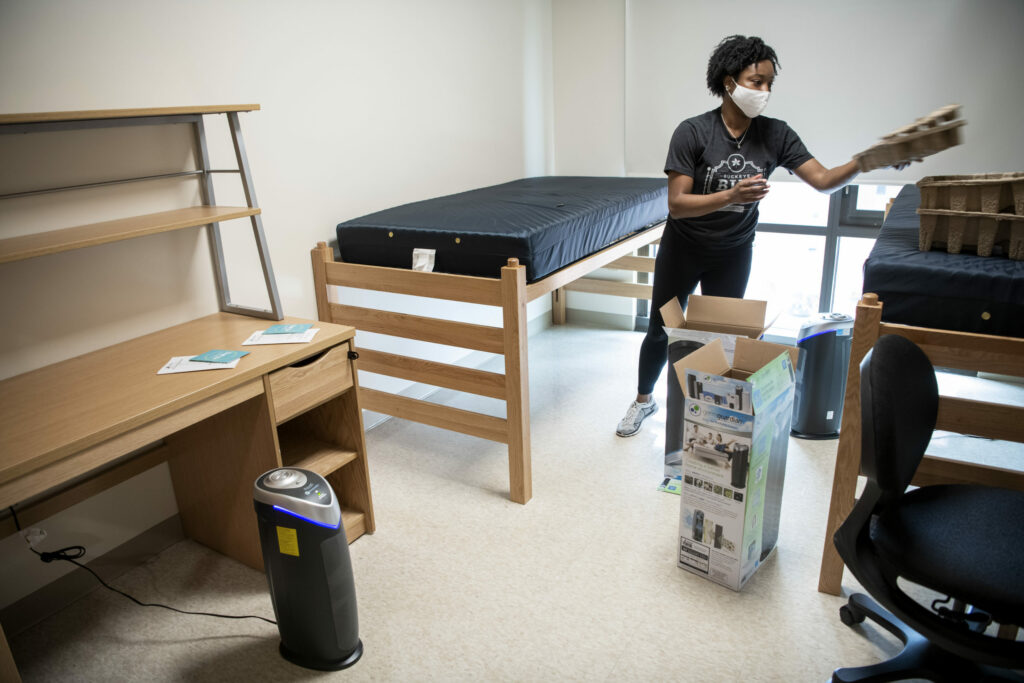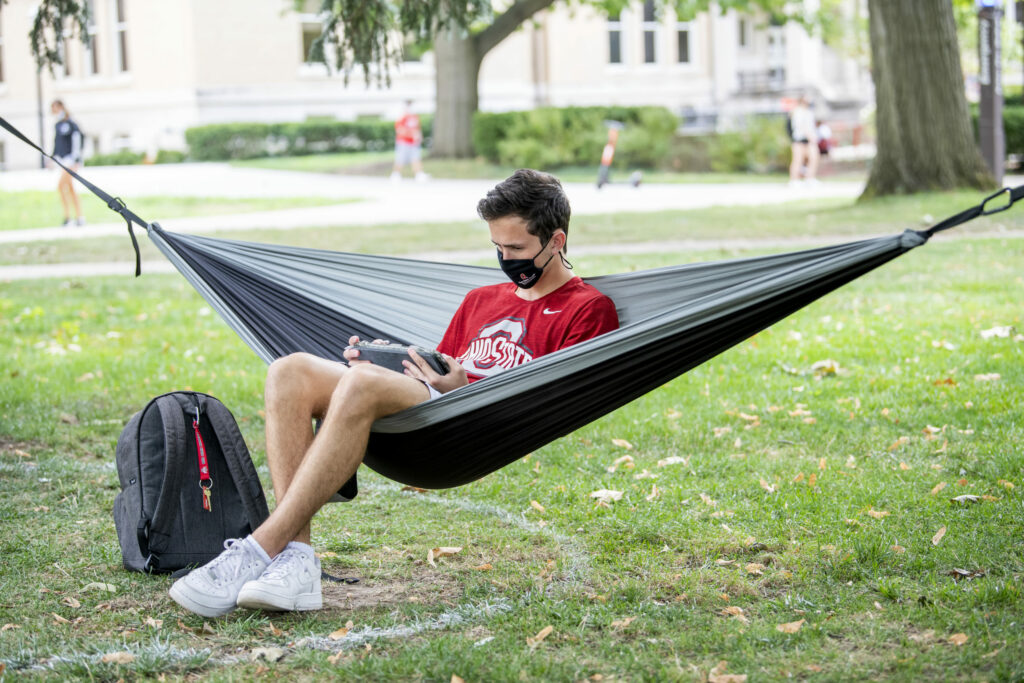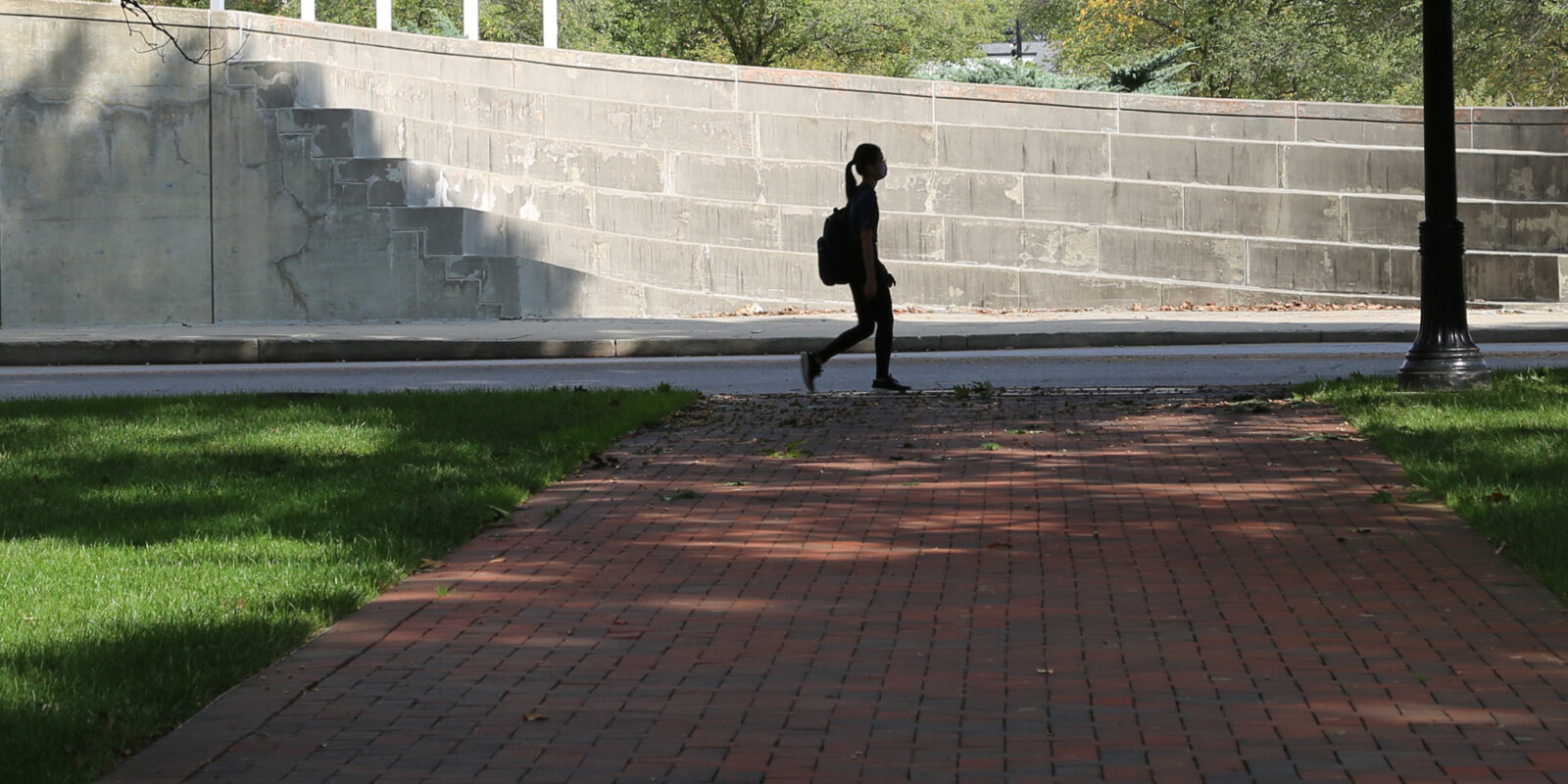She and her sister — raised by a single mom — learned long ago to find workarounds to limited resources. In high school, Baker bicycled to her job at an ice cream shop. Last year, she took public transport 90 minutes each way for her teacher observation. “I’m sleeping on an air mattress right now because I can’t afford a bed,” she said.
Baker doesn’t ask for any favors. It’s not in her nature.
But when she broke her foot roughhousing with her sister just before fall classes, a tenuous situation fell apart. She’d just paid her security deposit, first and last month’s rent, a requirement of most campus area landlords before tenants can move in. Her bank balance was reduced to double digits, and now she couldn’t work.
Even sharing leftover mac and cheese with roommates gave her pause. That was supposed to be tonight’s dinner.
35% Percentage of EHE students demonstrating high to moderate levels of financial need
53% Percentage of EHE students demonstrating some level of financial need
Source: College of Education and Human Ecology
Baker is among millions of American college students managing to pay for food, books and rent while at the same time amassing student loan debt. She has purposefully not focused on the balance she will owe.
The financial part is kind of scary, because I feel like I don’t even know all that money that I’m going to owe that’s lurking behind the curtains,” she said. “I’m going to graduate and kind of be flooded.”
Sixty-two percent of students graduating from public and private nonprofit colleges in 2019 had student loan debt, with balances averaging $28,950, according to the Institute for College Access and Success. Just under half of last year’s Ohio State undergraduates owed slightly less on average, $27,133, while Education and Human Ecology students with loans owed an average of $27,564.
Nationwide, the number of outstanding U.S. student loans is staggering, totaling almost $1.7 trillion, according to a 2021 report by the Federal Reserve. The loans account for the second largest category of household debt, behind residential mortgages.
Dean Don Pope-Davis committed to addressing the problem after seeing a GoFundMe poster in Campbell Hall — a cash-strapped student was asking for help.
“I turned around and said, ‘We’ve got to do something about it,’” he said. “That stuck with me.”
You can help a student graduate from college by giving to the College of Education and Human Ecology’s new Inspire Their Future Scholarship Fund.
The debt of students is one of the biggest challenges in higher education today. We have people who are removed from college 10, 15, 20 years, and they still have debt they are trying to get rid of.”
Ohio State President Kristina Johnson announced in February an initiative to allow undergraduates to earn degrees debt free in a decade. Scholarships, paid internships and lowering the cost of attendance are among possible solutions.
“This is well within our reach, and we will lead the nation, as the first university to offer a zero-debt bachelor’s degree at scale,” she said at her first State of the University address.
Pope-Davis is creating a task force that will coordinate with the university, but also work with students to determine how to best eliminate student debt. Providing more scholarships and reducing the time to degree — the number of credit hours or semesters needed to graduate — are options.
“I want to take a look at strategies as to how we can serve our students,” he said. “If we’re going to be student centric, it’s not just about giving them the best quality education. Equity also means giving education in a way in which the costs do not depress students’ financial resources so that they can’t be part of our inclusive community.”

What’s changed about student debt?
Many alumni recall scraping by on student loans, minimum-wage jobs and a steady diet of ramen noodles and cheap pizza. Depleted bank accounts are a rite of passage for college students, right?

Maybe so, but post-graduation outcomes are worse for today’s students because the cost of college has trended upward for the last two decades, said Stuart Heckman, ’14 PhD, and now associate professor of personal financial planning at Kansas State University.
The cost (of education) has increased so much faster than the wages have,” he said. “The idea that you could work a summer and save up that income to pay for your next year of college? That is not really possible anymore.”
Pell Grants, capped at $6,345 in 2020-21, are a good example. “It used to be that a Pell Grant from the federal government would cover tuition at a place like Harvard. Pell Grants come nowhere close to covering the full cost of education,” Heckman said.
The main culprits for increased higher ed costs are not inflated faculty salaries or even administrative costs, he said.
“It’s not that the overall cost of delivering the education is higher,” Heckman said. “It’s been a policy choice at the state level to decrease the subsidy to higher education. If you just look at how state funding has changed over time to the public institutions, as a proportion of the overall budget, it has gone down pretty substantially.”
Ohio is on the lower end of that scale. According to a 2017 Pew Research study, only nine other states provide less state funding per full-time student. The share students and families must pay has increased.
62% = students graduating in 2019 with student loan debt
47% = Ohio State undergraduate students who graduated with debt in 2020
58% = Education and Human Ecology students who graduated with debt in 2020
$28,950 = their average balance
$27,133 = their average balance
$27,564 = their average balance
Source: Institute for College Access and Success, The Ohio State University
The downside of over-working
Student loan debt creates a drag on the overall economy, experts say, stalling homeownership and the ability to fund small businesses. Mental strain can also result, on graduates but also students trying to avoid debt in the first place.
In addition to taking classes full-time, fourth-year teaching and learning student Jasmine Hasanain works 40 hours weekly as a restaurant server and babysitter. Her freshman year, her mother took a second job, working 80 to 100 hours per week to help fund her daughter’s education. Now Hasanain’s younger sister attends Ohio State, too. The preservice teacher became financially independent last year.
“It’s kind of just like a whole running joke in my generation,” she said. “Everyone’s in debt. You’re not the only one. It will get paid, eventually. It is a little overwhelming when I think about it in the grand scheme of things, but then I also remember how fortunate I am to have such little debt” compared to other students.
Even with her income and scholarships, Hasanain has accumulated student loans. She’s stashing away savings when she can to pay down the balance.
She manages to maintain a high GPA, squeezing in study time while her babysitting charge sleeps. Research shows, however, that when college students work more than 20 hours per week, their academics can suffer.
A lot of those students aren’t sleeping much,” Heckman said. “They come to class and they’re barely able to engage. The risk they run is then having to repeat classes” — or being forced to drop out.
Fear of student debt can be a positive motivator, Heckman said. Still, “you can go too far and take on too many things, because you do have to have the mental capacity and the healthy lifestyle to be able to engage in your coursework.”
Scholarships, grants key to reducing debt
Through its Consumer and Family Financial Services program, the college for years has been a national leader in assessing student debt and the stress associated with it. As a PhD student, Heckman worked with Professor Catherine Montalto on the Ohio precursor to the National Student Financial Wellness Study, first released by Ohio State in 2014. Montalto has been co-investigator for three multi-institutional studies examining undergraduate students’ financial attitudes, practices and knowledge.

“We’re really trying to understand what is a holistic portrait of students’ financial experiences — so, everything from their thoughts about the future, their current financial management tactics and how they’re paying for college,” said Erica Regan, director of Ohio State’s Center for the Study of Student Life and co-author of the 2020 study, now called the Study on Collegiate Financial Wellness.
The study found that 80% of students surveyed rely on scholarships and grants to fund college.
“It is the most commonly reported source of education funding,” Regan said.
The finding underscores the critical need for scholarships and grants to curb student debt. For the 2021-22 academic year, the college distributed $2.1 million in scholarships to the 791 students, an increase of 25% awardees over the year before.
We did a lot of things to reorganize the college’s Office of Advancement around generating more scholarship funds, including hiring a staff member to manage them,” Pope-Davis said.
The college also has launched a new scholarship fund to help achieve President Johnson’s goal. The Inspire Their Future Scholarship provides one or more scholarships to undergraduate students enrolled in any college degree program, with award preference given to those with the greatest financial need.
Those kinds of scholarships are critical for students like Baker, who would not be at Ohio State without them. They can reduce the burden for students like Hasanain, so she and others can truly focus on the learning opportunities before them.
The Study on Collegiate Financial Wellness shows that while 75% of students are stressed about finances, 66% remain optimistic about the future, Regan said.
College is a good investment, particularly over the life course,” she said. “Students with a bachelor’s degree make significantly more in earnings and income, over the course of their lifetimes, compared to individuals who do not have a college degree.”
Baker — who struggled with a learning disability as a child — wants to put her experiences to work, recognizing hidden problems in her students.
“I think teachers who’ve had a lot of life experiences outside of training — living in different kinds of neighborhoods, with different kinds of friends, different kinds of struggles — that definitely helps with the career,” she said. “Especially when you’re working with young minds and young people, you have to have a little more sensitivity and emotion and understanding for things that happen in life …. School is school, but life comes first.”
Baker is determined to come out on top. She only wants the chance to help children do the same.
Students of Color have a higher level of financial need in comparison to their White counterparts.
88% Percentage of EHE African American students demonstrating some level of financial need
65% Percentage of EHE African American students demonstrate the highest level of financial need
47% Percentage of EHE LatinX students demonstrating the highest level of financial need
77% Percentage of EHE LatinX students demonstrating some level of financial need
32% Percentage of EHE white students demonstrating the highest level of financial need
67% Percentage of EHE white students demonstrating some level of financial need
Source: College of Education and Human Ecology

